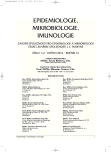Microneutralization Assay in the Diagnosis of Influenza Infection
Authors:
Havlíčková Martina 1; Jiřincová Helena 1; Marešová Vilma 2; Džupová Olga 3; Limberková Radomíra 1
Authors‘ workplace:
Státní zdravotní ústav, Centrum epidemiologie a mikrobiologie, Praha
1; Univerzita Karlova v Praze, 2. lékařská fakulta, Praha
2; Nemocnice Na Bulovce, Praha
3
Published in:
Epidemiol. Mikrobiol. Imunol. 61, 2012, č. 1-2, s. 9-14
Overview
Serology plays an important role in the diagnosis of influenza, particularly in the detection of post-vaccination and post-infection antibodies. When considering the range of diagnostic options, the serological method should be selected depending on the circumstances – whether single or paired serum samples are tested, whether adequate patient medical history data are available, whether epidemiological links are suspected, and, in particular, to what purpose the result will be used (differential diagnosis, post-infection follow-up, post-vaccination monitoring, etc.). The virus neutralization assay is one of the most sensitive and most objective serological tests, but it is highly dependent on the reaction balance and quality of the virus used. Determining the protective titer is crucial for the routine practice. Based on our experiments, we concluded that the virus neutralizing antibody titers are up to eight times as high in comparison with the hemaglutination inhibition test (HIT) or complement fixation reaction (CFR), but the correlation varies and is significantly influenced by interindividual variation in anti-neuraminidase antibodies and those against some internal proteins of influenza virus. We assume that the protective titer in the virus neutralization assay will be not less than 1 : 80. The predictive value of the titers below 1 : 40 is questionable.
Key words:
serology – virus neutralization – influenza virus – protective titers.
Sources
1. http://www.who.int/csr/resources/publications/swineflu/ realtimeptpcr/en/index.html.
2. World Health Organization: Manual for the Laboratory diagnosis and virological surveillance of influenza. 2011, ISBN: 9789241548090. Dostupné na www: www.who.int/ csr/disease/influenza/manual_diagnosis_surveillance_influenza/en/.
3. Lennette, E. H., Schmidt, N. J. Diagnostic procedures for viral, rickettsial, and chlamydial infections. Marcel Dekker, Inc: New York, 1992.
4. Rowe, T., Abernathy, R. A., Hu-Primmer, J., Thompson, W. W., Lu, X., Lim, W., Fukuda, K., Cox, N. J., Katz, J. M. Detection of antibody to avian influenza A (H5N1) virus in human serum by using a combination of serologic assays. J. Clin. Microbiol., 1999, 37, p. 937–943.
5. Harmon, M., Rota, P. A., Walls, W., Kendal, A. P. Antibody response in humans to influenza virus type B host--cell-derived variants after vaccination with standard (egg--derived) vaccine or natural infection. J. Clin. Microbiol., 1988, 26, p. 333–337.
6. Monto, A. S., Maasab, H. F. Ether treatment of type B influenza virus antigen for the hemagglutination inhibition test. J. Clin. Microbiol., 1981, 13, p. 54–57.
7. Lehtoranta, L., Villberg, A., Santanen, R., Ziegler, T. A novel, colorimetric neutralization assay for measuring antibodies to influenza viruses. J. Virol. Methods., 2009, p. 271–276.
8. Wang, W., Butler, E. N., Veguilla, V., Vassell, R., Thomas, J. T., Moos, M. Jr., Ze, Z., Hancock, K., Weiss, C. D. Establishment of retroviral pseudotypes with influenza hemagglutinins from H1, H3 and H5 antibodies subtypes for sensitive and specific detection of neutralizing antibodies. J. Virol. Methods, 2008, p. 111–119.
Labels
Hygiene and epidemiology Medical virology Clinical microbiologyArticle was published in
Epidemiology, Microbiology, Immunology

2012 Issue 1-2
Most read in this issue
-
30 let od popsání prvních případů AIDS – historie a současnost
Část I. - Outbreaks of Viral Hepatitis E in the Czech Republic?
- The Comparison of Selected Virulence Factors in Pseudomonas aeruginosa Catheter Isolates
- Lyme borreliosis – Epidemiological Analysis of Incidence in the Northern Region of Slovakia
